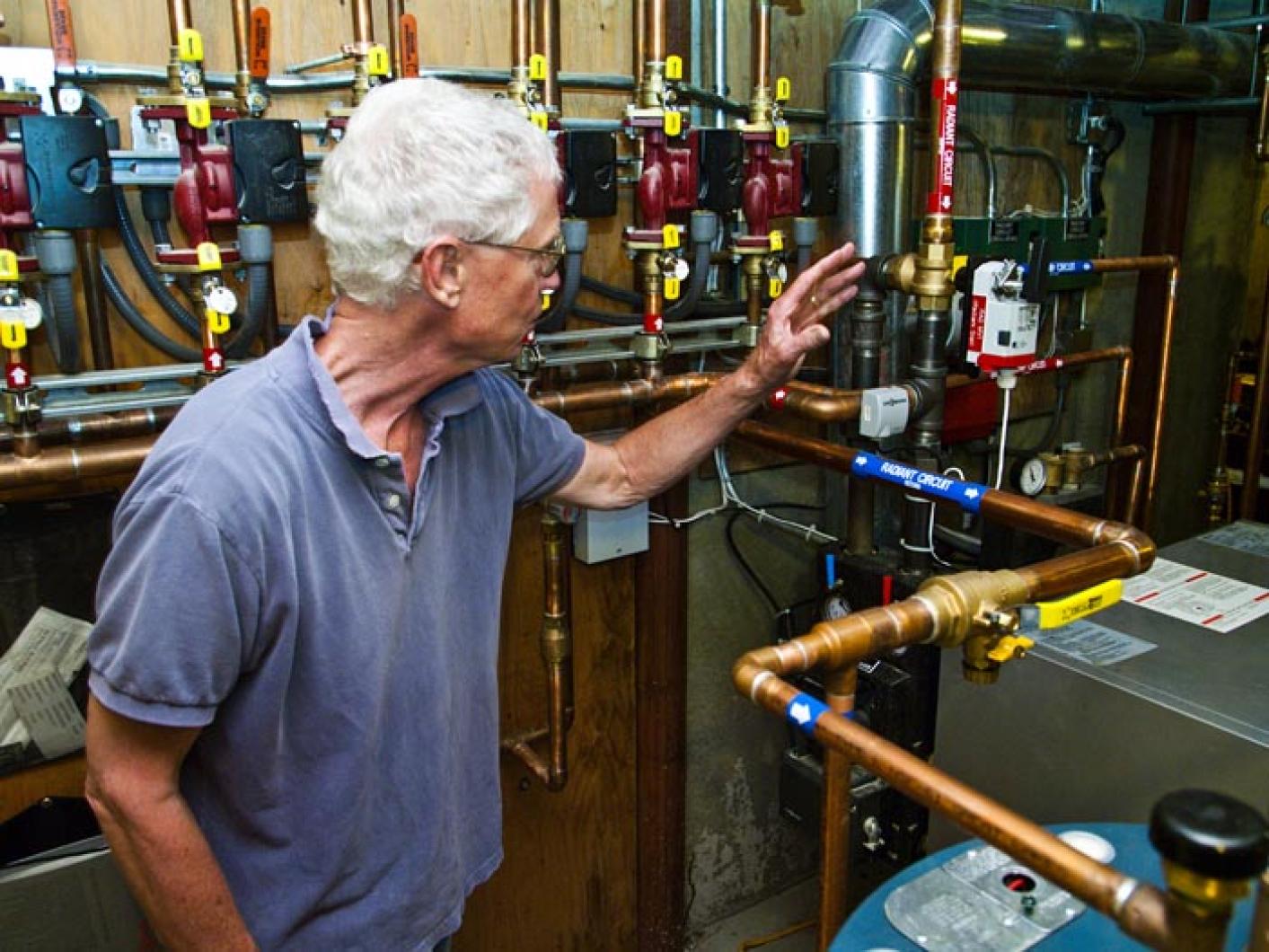To glimpse far into the future on the Vineyard, just visit the house of Ted Bayne in West Tisbury. Nothing levitates, lycra unitards are not standard and it is by all appearances much the same as any other typical Vineyard house circa 2011. The only difference is that, energy-wise, Mr. Bayne and his family are almost entirely self-sufficient, thanks in large part to a century-old and decidedly unsexy piece of equipment: the heat pump.
“I’m fulfilling the Island plan 38 years early,” he said at his home on a recent July day, referring to the Martha’s Vineyard Commission’s long-term planning document that calls for a near elimination of fossil fuels for Island home heating by 2050. Mr. Bayne is also a member of the board of directors for Vineyard Power, the fledgling Island energy cooperative.
Brian Nelson and David Sprague of Nelson Mechanical Design in West Tisbury recently installed the Japanese-made Daikin air-to-water heat pump at Mr. Bayne’s house, the only one of its kind on the Island. The unit outwardly resembles a small central air conditioning unit, and with good reason, as it relies on the same principles of refrigeration, only in reverse, extracting heat from the surrounding air to heat Mr. Bayne’s radiant floors and domestic hot water system. The term “heat” is misleading, though, as the pump is effective in a surprising range of conditions.
“You could come out here when it’s 10 degrees out and this tube will be negative 20 degrees,” Mr. Nelson said, gesturing to the refrigerant coils in the back of the unit. While it may not be as flashy as the swath of photovoltaic panels on Mr. Bayne’s roof, Mr. Nelson suspects that it will play a vital part in the Island’s prospective energy independence.
“The heat pump is critical to making the Vineyard all-electric,” he said. Mr. Nelson’s confidence in the technology is grounded in simple economics. While he has installed geothermal heating systems on a number of projects, including at the West Tisbury home of Alexander Boyle, which won a national award for the most innovative green energy design in the country, Mr. Nelson sees the air-to-water heat pump as becoming more attractive than geothermal for two reasons: Geothermal is very expensive to install, around $50,000, and requires tearing up homeowners’ backyards. An air-to water heat pump like Mr. Bayne’s costs $20,000, compared to $10,000 for a traditional propane boiler. Mr. Nelson claims it will pay for itself within five to six years.
“It makes the Island Plan realistic,” he said. “Instead of the playground of the rich, it makes it the playground of real people.”
The resurgence of the heat pump as a technology also points to the decades-long stagnation of energy efficient design in America during the age of oil.
“They had this technology in 1920 with carbon dioxide as a refrigerant medium,” said Mr. Nelson. “It’s all market driven. All the utilities in the 1930s and 1940s had these systems installed in their home offices to show customers coming in what heat pumps look like. Then cheap oil just demolished that. In the 1960s and 1970s the Japanese took our innovations from the 20s and 30s and made them better.”
A lot better. Opening a panel on the box, Mr. Sprague reveals the innards of the machine, a bouquet of circuits and electronic doohickeys that he thinks resemble “the inside of a nuclear submarine.” This is what makes the unit cutting edge.
“This knows the temperature outside, the temperature inside and the temperature you’re looking for and it’s constantly shaving efficiencies,” he said.
Mr. Bayne also has a state-of-the-art propane water boiler in his house that will operate in concert with the heat pump during the winter, but the basics of thermodynamics cap any fossil fuel-based boiler’s efficiency at just over 90 per cent. Simple electric baseboard heating is 100 per cent efficient but the heat pump is more than 400 per cent efficient — that is, it produces four times more energy than it requires to operate.
“It’s not a perpetual motion machine; we’re not sidestepping the laws of physics,” said Mr. Nelson. “We’re taking free heat from sun that is in the air. It’s just another form of solar power.”
With solar panels on his roof and the heat pump warming his house, Mr. Bayne is able to tap into renewable energy and less of it.
“It’s always more efficient to move heat than to generate it,” said Mr. Sprague.
For Mr. Bayne the pump will hopefully keep the propane delivery man well rested.
“I got a bill last Christmas for a six week period for $1,200 of propane,” he said. “I have photovoltaics on my roof and for a long time I’ve been tugging at these guys to get my air-to-water unit and I finally got my question answered of why it took so damn long. It was the perception of Daikin that fuel prices were low and there wouldn’t be a demand.”
With propane at $4.21 a gallon and poised only to increase in coming years Mr. Nelson is optimistic that demand is beginning to emerge among pinched consumers.
“The sun will never send you a bill,” he said.





Comments
Comment policy »